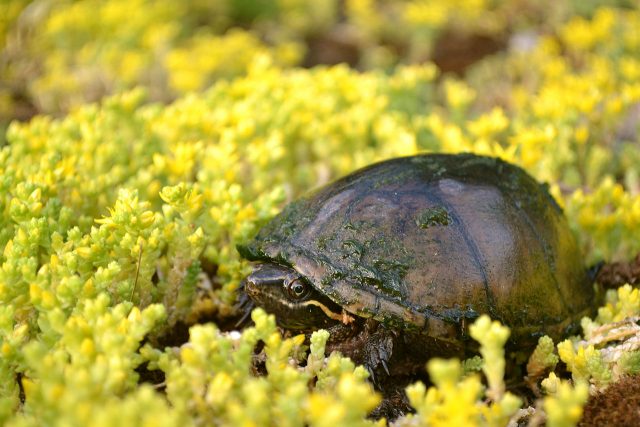| Place of Origin and Range |
The common musk turtle ranges in southern Ontario, southern Quebec, and in the Eastern United States from southern Maine in the north, south through to Florida, and west to central Texas, with a disjunct population located in central Wisconsin. |
| Description |
They have long necks and rather short legs. The yellow lines on the neck are a good field marker, and often can be seen from above in swimming turtles. Males can usually be distinguished from females by their significantly longer tails and by the spike that protrudes at the end of the tail. The anal vent on the underside of the tail extends out beyond the plastron on males. Females are also typically larger than males. The head is vaguely triangular in shape, with a pointed snout and sharp beak, and yellow-green striping from the tip of the nose to the neck. Barbels are present on the chin and the throat. |
| Morph Patterns Available |
Yes |
| Adult Size |
Can grow up to 5in(13cm) |
| Accommodation |
A filtered aquarium with water temperature at 70-80'F(21-26'C), and a sloping ramp(driftwood, textured plastic or some other non-abrasive surface) leading from the bottom to an illuminated and warmed basking spot. Approx 80'F(27'C). |
| Lifespan |
Can live 15+ years |
| Feeding / Diet |
They are carnivorous, consuming a wide variety of aquatic invertebrates including crayfish, freshwater clams, snails, aquatic larvae, tadpoles and various insects. They will also eat fish and carrion. A hatchling's diet is much more carnivorous than an adult's, and may slowly acquire a taste for aquatic plants as the turtle matures. |
| Breeding |
Breeding occurs in the spring, and females lay two to 9 elliptical, hard-shelled eggs in a shallow burrow or under shoreline debris. An unusual behaviour is the tendency to share nesting sites; in one case there were 16 nests under a single log. The eggs hatch in late summer or early fall. Egg predation is a major cause of mortality, as with many turtle species. In one Pennsylvania population, hatching success was only 15 percent, and predators alone destroyed 25 of 32 nests. Hatchlings are usually less than one inch long and have a very ridged shell which will become less pronounced as they age and will eventually be completely smooth and domed. |
| Other Considerations |
Wild turtles often will not hesitate to bite if harassed. A musk turtle's neck can extend as far as its hind feet; caution is required when handling one. Watch for theses health concerns carefully with your turtle. Vitamin A Deficiency: Vitamin A is an important nutrient for your turtle’s health. It is found in his diet in the form of leafy green, orange or yellow vegetables, liver, and fish. If your turtle is not getting enough Vitamin A, he can suffer serious health problems. Always check to make sure that your turtle does not have swollen eyelids, as this is the main sign of a Vitamin A deficiency. Also, check for weight loss, nasal discharge and infected skin. Any of these symptoms could point to a deficiency. If you think your turtle may not be getting enough Vitamin A, you should take him to the veterinarian to get a firm diagnosis. Shell Problems: Your turtle’s shell is very important to his overall health. There are many potential problems that could occur, so you should be on the lookout at all times. Respiratory Disease: Respiratory infections have symptoms similar to vitamin A deficiency, including swollen eyelids and runny nose, so you should take your turtle to the veterinarian to get a proper diagnosis if you suspect either. More serious infections will be characterized by breathing through the mouth, mucus in the mouth, and wheezing. Always make sure your turtle’s environment has the proper amount of humidity, as this will help prevent respiratory problems.
|




